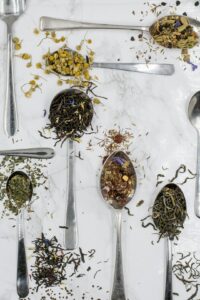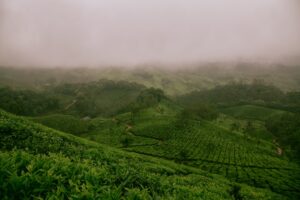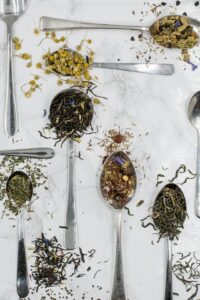Support our educational content for free when you purchase through links on our site. Learn more
What Plant to Grow for Green Tea? [2024]
Have you ever wondered what plant is used to make that delicious cup of green tea you enjoy every morning? Well, you’re in luck! In this article, we will explore the fascinating world of green tea and uncover the secrets behind the plant that produces this beloved beverage. So grab your favorite mug and let’s dive in!
Quick Answer
To make green tea, you need to grow the Camellia sinensis plant. This plant is native to China and is the same species used to produce black tea. However, the processing methods differ, resulting in the distinct flavors and characteristics of green tea. Growing your own Camellia sinensis plants can be a rewarding experience, allowing you to have a fresh supply of tea leaves right in your backyard.
✅ Shop Camellia sinensis plants on Amazon
Quick Tips and Facts
- Green tea comes from the same plant species as black tea, Camellia sinensis.
- There are two main varieties of the Camellia sinensis plant: Camellia sinensis sinensis and Camellia sinensis assamica.
- Camellia sinensis sinensis is used to make green and white teas and is native to China.
- Camellia sinensis assamica is used to produce strong black teas and was first discovered in the Assam district of India.
- Green tea is processed by quickly heating and drying the tea leaves to prevent oxidation.
- The origins of green tea can be traced back to China, and it was later popularized in Japan around 1190.
- Chinese green teas are pan-fired, while Japanese green teas are steamed.
- The caffeine content in green tea ranges from 24 to 40 mg per 8 oz. cup.
- Green tea should be consumed within six months to a year of purchase and stored in a cool, dark place.
- When brewing green tea, use fresh, pure, cold filtered water and steep at around 160 to 180 degrees Fahrenheit for 30 seconds to 3 minutes.
Background: The Camellia Sinensis Plant
The Camellia sinensis plant is a small evergreen shrub that belongs to the Theaceae family. It is native to East Asia and is cultivated for its leaves, which are used to produce various types of tea, including green tea. The plant has glossy, dark green leaves and produces fragrant white flowers. It thrives in subtropical climates with well-drained soil and partial shade.
Tea Plant Varieties
There are two main varieties of the Camellia sinensis plant: Camellia sinensis sinensis and Camellia sinensis assamica. These varieties have different characteristics and are used to produce different types of tea.
-
Camellia sinensis sinensis: This variety is used to make green and white teas. It is native to China and is known for its delicate flavor and aroma. Some popular green teas made from Camellia sinensis sinensis include Longjing (Dragon Well) and Bi Luo Chun.
-
Camellia sinensis assamica: This variety is used to produce strong black teas. It was first discovered in the Assam district of India and is now cultivated in other parts of the world as well. Assam tea is known for its robust flavor and is often used in breakfast blends.
When growing tea plants, it’s important to choose the variety that suits your taste preferences and growing conditions.
Green Tea Processing
The processing methods used for green tea are different from those used for black tea. Green tea leaves are picked and then quickly heated or steamed to prevent oxidation. This step helps to preserve the natural green color and fresh flavor of the leaves. After heating, the leaves are rolled and dried to remove any remaining moisture.
The precise processing methods can vary depending on the type of green tea being produced. Chinese green teas, such as Longjing and Bi Luo Chun, are traditionally pan-fired in large woks to stop the oxidation process. This gives them a distinctive toasty flavor. On the other hand, Japanese green teas, like Sencha and Matcha, are steamed, resulting in a vibrant green color and a grassy, vegetal taste.
Green Tea Origins
Green tea has a rich history that dates back thousands of years. It originated in China, where it has been consumed for its health benefits and refreshing taste for centuries. The cultivation and consumption of green tea later spread to other parts of Asia, including Japan, Korea, and India.
In Japan, green tea became an integral part of the country’s culture and was even used in traditional tea ceremonies. The Japanese perfected the art of growing and processing green tea, producing some of the finest green teas in the world.
Types of Green Tea
Green tea comes in a variety of types, each with its own unique flavor profile and characteristics. Here are some popular types of green tea:
-
Sencha: This is the most commonly consumed green tea in Japan. It has a refreshing, grassy flavor and a vibrant green color.
-
Matcha: Matcha is a powdered green tea that is used in traditional Japanese tea ceremonies. It has a rich, umami flavor and a vibrant green color.
-
Longjing (Dragon Well): Longjing is a famous Chinese green tea that is known for its flat, sword-shaped leaves and chestnut-like flavor.
-
Bi Luo Chun: This Chinese green tea is made from young tea buds and has a delicate, fruity flavor.
-
Gyokuro: Gyokuro is a high-quality Japanese green tea that is shaded before harvesting. This process gives it a rich, sweet flavor and a deep green color.
These are just a few examples of the many types of green tea available. Each type has its own unique flavor profile, so feel free to explore and find your favorite!
Caffeine Content in Green Tea
Green tea contains caffeine, although the amount can vary depending on factors such as the type of tea and the brewing method. On average, an 8 oz. cup of green tea contains between 24 to 40 mg of caffeine. This is significantly less than the caffeine content in coffee, making green tea a popular choice for those looking for a milder caffeine boost.
It’s worth noting that the caffeine content can also be influenced by the brewing time and temperature. Steeping green tea for a shorter time and at a lower temperature can result in a lower caffeine content.
Tasting Green Tea
Tasting green tea is a sensory experience that involves observing the appearance, smelling the aroma, and savoring the flavor. Here are some tips to help you appreciate the nuances of green tea:
-
Appearance: Observe the color of the brewed tea. Green teas can range from pale yellow to vibrant green, depending on the type and processing method.
-
Aroma: Take a moment to inhale the aroma of the tea. Green teas often have a fresh, grassy scent with hints of vegetal or floral notes.
-
Flavor: Sip the tea and let it linger on your palate. Notice the taste and texture. Green teas can have a range of flavors, from vegetal and nutty to floral and sweet.
Each type of green tea has its own unique flavor profile, so take the time to explore and discover your preferences.
Buying and Storing Green Tea
When buying green tea, it’s important to choose high-quality tea leaves to ensure the best flavor and health benefits. Here are some tips for buying and storing green tea:
-
Choose loose-leaf tea: Loose-leaf green tea allows the leaves to fully expand during brewing, resulting in a more flavorful cup of tea.
-
Look for freshness: Check the packaging for the harvest date or expiration date. Green tea is best consumed within six months to a year of purchase.
-
Store properly: To maintain the freshness of green tea, store it in an airtight container in a cool, dark place. Avoid exposure to light, heat, and moisture, as these can degrade the quality of the tea.
By following these tips, you can ensure that your green tea stays fresh and flavorful for longer.
Preparing Green Tea
To get the most out of your green tea, it’s important to prepare it properly. Here are some general guidelines for brewing green tea:
-
Water: Use fresh, pure, cold filtered water for the best results. Avoid using water that has been previously boiled or has a strong taste, as it can affect the flavor of the tea.
-
Temperature: Green tea is best brewed at a lower temperature compared to black tea. Aim for a water temperature of around 160 to 180 degrees Fahrenheit (70 to 82 degrees Celsius). If you don’t have a thermometer, you can achieve this temperature by letting the water cool for a few minutes after boiling.
-
Steeping time: The steeping time can vary depending on the type of green tea and your personal preference. Generally, green tea is steeped for 30 seconds to 3 minutes. Start with a shorter steeping time and adjust to taste.
-
Enjoy: Once the tea has steeped, strain the leaves and pour the tea into your favorite cup. Take a moment to savor the aroma and flavor of the tea. You can enjoy green tea plain or add a touch of honey or lemon for extra flavor.
Experiment with different brewing methods and steeping times to find the perfect cup of green tea that suits your taste.
FAQ
What plants do you need to make green tea?
To make green tea, you need to grow the Camellia sinensis plant. This plant is native to China and is the same species used to produce black tea. However, the processing methods differ, resulting in the distinct flavors and characteristics of green tea.
Read more about “How to Make Tea from Camellia Sinensis …”
Can you grow your own green tea plants?
Yes, you can grow your own green tea plants. The Camellia sinensis plant can be grown in a variety of climates, as long as the conditions are suitable. It thrives in subtropical climates with well-drained soil and partial shade. Growing your own green tea plants can be a rewarding experience, allowing you to have a fresh supply of tea leaves right in your backyard.
Read more about “… Cold Hardy Tea Plants for Sale: A Comprehensive Guide”
How long does green tea take to grow?
Green tea plants typically take around 3 to 5 years to reach maturity and start producing tea leaves. However, you can start harvesting leaves for tea as early as the second year of growth. The exact timing can vary depending on factors such as the variety of tea plant and the growing conditions.
Read more about “Can You Grow Your Own Camellia sinensis? …”
Can you grow tea tree in the USA?
Yes, it is possible to grow tea plants in the USA. While tea is traditionally grown in countries with subtropical climates, such as China, Japan, and India, there are regions in the USA where tea cultivation is feasible. Some areas in the southern states, such as South Carolina, Georgia, and Hawaii, have successfully established tea plantations. However, growing tea in the USA can be challenging due to the specific climate and soil requirements of the tea plant.
For more information about growing green tea in the USA, check out our article on 7 Surprising Facts About Growing Green Tea in the US 2024.
Read more about “7 Surprising Facts About Growing Green Tea in the US …”
Conclusion
Growing your own green tea plants can be a rewarding experience that allows you to enjoy the freshest and most flavorful tea right from your backyard. By choosing the right variety of Camellia sinensis and following proper cultivation and processing methods, you can produce your own high-quality green tea.
Remember to pay attention to the processing methods, as they play a crucial role in determining the flavor and characteristics of green tea. Whether you prefer the toasty flavors of Chinese green teas or the grassy notes of Japanese green teas, there is a wide variety of options to explore.
So why not embark on your own tea-growing journey and discover the joys of cultivating and brewing your own green tea? Cheers to a delicious and satisfying cup of tea!
Recommended Links
- Green Tea Cultivation
- Herbal Tea Planting
- Tea Plant Varieties
- Soil and Climate for Tea
- 7 Surprising Facts About Growing Green Tea in the US 2024










